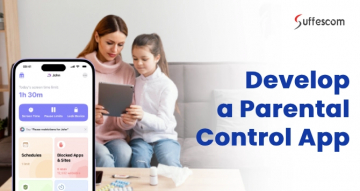Mobile App Development Life Cycle: Explore Essential Phases

The world is expected to have more than 7.26 billion by 2022. In 2025, the number of mobile users worldwide is projected to reach 7.49 billion as per the last year report by market researcher Statista. Businesses are seeing it as an opportunity to promote their services and lure more potential customers. This leads to the need for a mobile application. In the modern technology-driven world, smartphone applications serve as a business tool that organizations can use to sell their services and stay connected with their clients. Google Play and Apple's App Store have more than 1.5 million apps each, and hundreds are being registered daily.
As mobile applications are very useful for a business, developing an app is common these days. However, the development life cycle of a mobile app is like a black box. It is essential for a business to identify how an app may serve its purpose and help the business to meet its marketing objectives. Whether it's an application for a small business or a big brand's app, there are some essential phases that should be executed one after another. Missing any of them can cause serious damage to the development process.
Follow The Best Mobile App Development Process
Why our developers follow the best mobile app development process? We have robust mobile app development life cycle plans to execute for advanced Custom, AI and dApp development. Considered Client's Idea Analysis, Research the market, Wire-framing, Prototype, Testing, Launch.
Different Phases of App Development process
When you get an idea about the different phases of mobile app development or how to develop iPhone mobile app, you will surely come across a lot of questions.
Your queries include the following things:
1. What do you need to know about Mobile app development phases?
2. What are the stages of mobile app development?
3. What are the steps of the mobile app development life cycle?
4. Efforts to develop a mobile app from scratch?
Undeniably, there will be some more queries, apart from the above. So, we have decided to write a blog on the topic that provides valuable information for our readers. Furthermore, you can bookmark this article if you want to learn about Mobile app development phases. Also, there are many more answers to what you can do with your mobile app development life cycle. So, keep reading
To understand the mobile app development cycle in details, below are the 8 major phases of the development process:
1. Research
Why do you want an app? It is essential to get an answer to the question before moving to the development phase. There should be an original idea and a solid objective behind the app. In addition, a business needs to understand what its customers require and how the app is going to meet those requirements. This phase is essential because it helps you identify why do you need the application and how should it look like.
2. Establish Objectives
This phase is associated with app planning. You need to identify the role a mobile app is going to play in your business. For example- It is essential to determine what problems the app is going to solve for customers. In addition, you must know what kinds of features the app needs to have. These things will help you learn in details about benefits and budget of the app.
3. Wire-frames
In this phase of the mobile app development process, you get an idea on how your app is going to look like and what features it must have. In addition, this part of the procedure will help you determine how your ideas and required features may come together to emerge as a road-map that gives you the clear idea of how your application may look after completion.
4. Back-end Structures
There must be an idea to support your app. This includes back-end plans on APIs, servers, data integration, and various other tools that support the back-end structure. While working on these requirements, you may come across situations that demand alteration in your wire-frames or the storyboard.
5. Prototype Testing
While working on the back-end structure, you may need to make some essential changes in your wire-frames due to technical limitations. Once you are done with those changes, you can move to the prototyping testing phase. This is an essential step as it provides you with an opportunity to examine design concepts and identify flaws in the flow. Here, you may also take help from people who are not linked to the app development process. The phase helps you finalize your app design concept and get a prototype that assists in the actual development procedure.
6. App Development
It is the most crucial phase of the mobile app development process which includes a number of steps. Here, your team of developers has to set up storage solutions and conduct the coding phase. In addition, designers will work on the app skin and create a real design for your application.
7. Testing
The testing phase is as important as the development process. Before the testing begins, you have a complete app concept that, if approved, is going to be used by the end-users. Before making the app available to all, it is essential to test it many times in different scenarios and on a variety of platforms.
8. Prepare For Launch
The final phase of the mobile app development process is preparing your application for the launch. Here, you need to involve your company's marketing department to ensure it notices all those things that could assist in creating awareness about the app. After that, you can officially announce your application.
When you follow all the phases, you get an application that serves its purpose effectively. Before starting with these phases of the mobile app development life cycle, make sure that you have a name for your app.
Explaining Mobile App Development Life Cycle in Simple Steps:
The Mobile Software Development Life Cycle can be broken down into eight different stages, and these are:
1: Planning State.
2: System Design.
3: Application Architect.
4: Prototyping.
5: Quality Assurance.
6: Maintenance.
7: Publishing.
8: Development.
Next, We are going to discuss the 9 stages of Mobile App Development in detail!
Stage 1: Planning
In the first phase of the mobile software development life cycle, you first need to research the market and analyze your competitor's iOS or android mobile apps for sale that you need. You can do this process in two primary ways, either you need to do a business analysis or look for a mobile strategy. When doing business analysis, one can determine the value of the products and measure the mobile app's Return on Investment (ROI). When doing business analysis, one can determine the value of the products and measure the mobile app's Return on Investment (ROI).
It will also help you to decide on maintaining a budget. On the other end, during the mobile strategy, you research the market for your products or services and create user personas. Also, you can create a detailed promotion in which the mobile app helps to grow your business.
Stage 2: Application Architect
In the second step of the mobile software development life-cycle, you have to decide the needed type of tech products that you want to use. Afterwards, you can create a detailed plan in order to keep on track of your progress. You can hire a technical writer who works to develop technical documentation, and the documentation will make your app easy to understand.
While understanding the stages of mobile app development, you need to hire a technical writer who typically works to create technical documentation. This documentation makes your app easy to understand and lays out ways to make changes to the app in the future. Sometimes a short manual for your app adds value so people can easily use it. This also makes it easier to reuse certain parts of the app in future endeavours. Besides, you can use the documentation in developing Mobile app development Life Cycle and ensure your strategies.
Stage 3: Prototyping in Stages of Mobile App Development
In stage 3, the mobile app development life-cycle, a visual representation of future apps emerges. You can make use of this visualization and correct the misconceptions regarding your product and company. The step might include:
Sketch of the App:
This will provide you with a clear picture of how the app will look. It consists of the logic, several pages, and the ways pages interact with one another.
Create Wire-frames:
In the phases of mobile app development, create wire-frames that show the structure's draft.
Clickable Prototype:
In the full-cycle of mobile application development, the user can find logical breaks and technical inconsistencies to correct before launching the app.
Create App Skins:
Once Mobile app development Life-Cycle has been completed, then you can put together all wire-frames and get a look at the final app.
Stage 4: Development
The Life Cycle of Mobile Application Development is made of two essential parts:
Mobile App Front-end development
When learning mobile app development phases, you need to think out of the box. It would help if you often considered the development that goes on the mobile app. It includes screen designing for getting different mobile layouts and integration of app screens with the back-end. Your goal is to create an app that will run on other devices quickly. It should also provide a meaningful experience for the users, and the individuals should be able to interact with it directly.
Back-end API development
The Life Cycle of mobile application development only concerns itself along with the server and database. The Back-end development involves the API layer, business logic, data storage, etc. In the Mobile app development Life Cycle, the front-end of the app gets connected to the server and data to provide and collect information.
Stage 5: Quality Assurance in Life Cycle of Mobile Application Development
Before you are out to sell the service in a market, make sure to keep a check on it. You need to ensure that the life-cycle of mobile application development provides benefits to your clients and is working correctly. Quality assurance is something where you need to find out things well. For compatibility testing, you need to run the app on different size screens and get various platforms to ensure it is working correctly.
Share Ideas & Know Mobile App Development Process
We follow advanced mobile app development process, consult with our experts from beginning to deployment. Our experienced mobile app developers can bring to you an application tailored your business needs.
Stage 6: Maintenance in Life Cycle of Mobile Application Development
Remember that you need to continue your infrastructure support for the Life-Cycle of mobile application development. You can either do this with an administration panel or cloud service. But you need to make sure that you will do this with an administration panel or cloud service. Also, make sure that the app continues to run smoothly, and you also need to find an app that will help promote your app to the top list. In this way, more people will see and use your app.
Ending Words!
While developing a Life-cycle of mobile application development, it reflects your business idea to your targeted audiences. Also, it requires a great deal of effort and a significant amount of time. However, following the proper Mobile app development phases from beginning to end, you must make your app a chart buster for your customers. We hope that sharing this information about the Life Cycle of Mobile Application Development will give you a better idea while selecting the best things for completing your project. We the best mobile app development company create never-seen-before Ideas to Can’t-Live-Without applications using cognitive technology. Contact us now!









